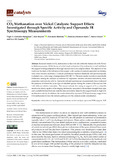Mostrar el registro sencillo del ítem
CO2 methanation over nickel catalysts: support effects investigated through specific activity and operando IR spectroscopy measurement
| dc.creator | González Rangulan, Vigni Virginia | es_ES |
| dc.creator | Reyero Zaragoza, Inés | es_ES |
| dc.creator | Bimbela Serrano, Fernando | es_ES |
| dc.creator | Romero Sarria, Francisca | es_ES |
| dc.creator | Daturi, Marco | es_ES |
| dc.creator | Gandía Pascual, Luis | es_ES |
| dc.date.accessioned | 2023-08-03T14:22:04Z | |
| dc.date.available | 2023-08-03T14:22:04Z | |
| dc.date.issued | 2023 | |
| dc.identifier.citation | González-Rangulan, V. V., Reyero, I., Bimbela, F., Romero-Sarria, F., Daturi, M., Gandía, L. M. (2023) CO2 methanation over nickel catalysts: support effects investigated through specific activity and operando IR spectroscopy measurement. Catalysts, 13(2), 1-25. https://doi.org/10.3390/catal13020448. | en |
| dc.identifier.issn | 2073-4344 | |
| dc.identifier.uri | https://hdl.handle.net/2454/45875 | |
| dc.description.abstract | Renewed interest in CO2 methanation is due to its role within the framework of the Power-to-Methane processes. While the use of nickel-based catalysts for CO2 methanation is well stablished, the support is being subjected to thorough research due to its complex effects. The objective of this work was the study of the influence of the support with a series of catalysts supported on alumina, ceria, ceria–zirconia, and titania. Catalysts’ performance has been kinetically and spectroscopically evaluated over a wide range of temperatures (150–500 °C). The main results have shown remarkable differences among the catalysts as concerns Ni dispersion, metallic precursor reducibility, basic properties, and catalytic activity. Operando infrared spectroscopy measurements have evidenced the presence of almost the same type of adsorbed species during the course of the reaction, but with different relative intensities. The results indicate that using as support of Ni a reducible metal oxide that is capable of developing the basicity associated with medium-strength basic sites and a suitable balance between metallic sites and centers linked to the support leads to high CO2 methanation activity. In addition, the results obtained by operando FTIR spectroscopy suggest that CO2 methanation follows the formate pathway over the catalysts under consideration. | en |
| dc.description.sponsorship | Financial support from Spanish Ministerio de Ciencia e Innovación and Agencia Estatal de Investigación MCIN/AEI/10.13039/501100011033/ and FEDER “Una manera de hacer Europa” (grant PID2021-127265OB-C21), as well as from Plan de Recuperación, Transformación y Resiliencia and NextGenerationEU (grants PLEC2022-009221 and TED2021-130846B-100) is gratefully acknowledged. Financial support from Universidad Pública de Navarra is also thanked for the PhD grant awarded to V.V. González-Rangulan. V.V. González-Rangulan also acknowledges the CNRS for the financial support, the guidance, and assistance provided during the 3-month research sojourn in ENSICAEN. L.M. Gandía also thanks Banco de Santander and Universidad Pública de Navarra for their financial support under “Programa de Intensificación de la Investigación 2018” initiative. | en |
| dc.format.mimetype | application/pdf | en |
| dc.language.iso | eng | en |
| dc.publisher | MDPI | en |
| dc.relation.ispartof | Catalysts 2023, 13(2), 448 | en |
| dc.rights | © 2023 by the authors. Licensee MDPI, Basel, Switzerland. This article is an open access article distributed under the terms and conditions of the Creative Commons Attribution (CC BY) license. | en |
| dc.rights.uri | http://creativecommons.org/licenses/by/4.0/ | |
| dc.subject | Carbon dioxide | en |
| dc.subject | Hydrogenation | en |
| dc.subject | Methane | en |
| dc.subject | Nickel catalysts | en |
| dc.subject | Operando FTIR | en |
| dc.subject | Support | en |
| dc.subject | TOF | en |
| dc.title | CO2 methanation over nickel catalysts: support effects investigated through specific activity and operando IR spectroscopy measurement | en |
| dc.type | Artículo / Artikulua | es |
| dc.type | info:eu-repo/semantics/article | en |
| dc.date.updated | 2023-08-03T14:15:12Z | |
| dc.contributor.department | Ciencias | es_ES |
| dc.contributor.department | Zientziak | eu |
| dc.contributor.department | Institute for Advanced Materials and Mathematics - INAMAT2 | en |
| dc.rights.accessRights | Acceso abierto / Sarbide irekia | es |
| dc.rights.accessRights | info:eu-repo/semantics/openAccess | en |
| dc.identifier.doi | 10.3390/catal13020448 | |
| dc.relation.projectID | info:eu-repo/grantAgreement/AEI//PID2021-127265OB-C21 | en |
| dc.relation.projectID | info:eu-repo/grantAgreement/AEI//PLEC2022-009221 | en |
| dc.relation.projectID | info:eu-repo/grantAgreement/AEI//TED2021-130846B-100 | en |
| dc.relation.publisherversion | https://doi.org/10.3390/catal13020448 | |
| dc.type.version | Versión publicada / Argitaratu den bertsioa | es |
| dc.type.version | info:eu-repo/semantics/publishedVersion | en |
| dc.contributor.funder | Universidad Pública de Navarra / Nafarroako Unibertsitate Publikoa | es |



